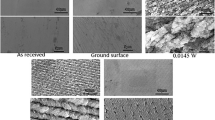Abstract
In this paper we present inspection results from several bonded wafer systems using a newly developed infrared gray-field polariscope (IR-GFP). This device measures the residual stress-fields associated with defects trapped at the bonded interface to enable the detection of subwavelength defects. Results from IR-GFP imaging are contrasted with conventional infrared transmission (IRT) imaging of the same samples, showing marked improvements in defect detection as well as the ability to quantify the residual stress fields. This inspection method reveals that interfaces deemed defect-free using IRT imaging may be, in fact, teeming with defects.
Similar content being viewed by others
References
Joch, A., “Silicon on Insulator,” Computerworld, December (2000).
Cristoloveanu, S. andCeller, G.K., “Frontiers of Silicon-oninsulator,” Journal of Applied Physics,93(9),4955–4978 (2003).
Maszara, W.P., Goetz, G., Caviglia, A., andMcKitterick, J.B., “Bonding of Silicon Wafers for Silicon-on-insulator,” Journal of Applied Physics,64(10),4943–4950 (1988).
International MEMS/MST/Top Down Nano Roadmap, http://www. mansef.org (2002).
Mirza, A.R., “Wafer-level Packaging Technology for MEMS,” Thermomechanical Phenomena in Electronic Systems — Proceedings of the Intersociety Conference, Las Vegas, NV, Vol.1,113–119 (2000).
London, A., Ayon, A., Epstein, A., Spearing, S.M., Harrison, T., Petes, T., andKerrebrock, J., “Microfabrication of a High Pressure Bipropellant Rocket Engine,” Sensors and Actuators A: Physical,92(1–3),351–357 (2001).
Epstein, A.H., andSenturia, S.D., “Macro Power from Micro Machinery,” Science,276(5316),1211 (1997).
Barth, P.W., “Silicon Fusion Bonding for Fabrication of Sensors, Actuators and Microstructures,” Sensors and Actuators A: Physical,23(1–3),919–926 (1990).
Wilson, R., “Wafer-bonding Technique Yields New Materials,” EE-Times, September (2003).
Müller, B. andStoffel, A., “Tensile Strength Characterization of Lowtemperature Fusion-bonded Silicon Wafers,” Journal of Micromechanics and Microengineering,1(3),161–166 (1991).
Mendicino, M.A. and Lage, C.S., “Better Models, Production Methods Expand SO1 Applications,” EETimes, September (2002).
Baumgart, H., Pinder, R.D., Steigmeier, E.F., Auderset, H., and de Kock, A.J.R., “Impact of Interface Preparation on Defect Generation During Wafter Bonding,” Proceedings of the IEEE SOS/SOI Technology Conference, Stateline, NV, 95–96 (1989).
Tsaur, B-Y., Fan, J.C.C., andGeis, M.W., “Stress-enhanced Carrier Mobility in Zone Metling Recrystallized Polycrystalline Si Films on SiO/sub 2/-coated Substrates,” Applied Physics Letters,40(4),322–324 (1982).
Tong, Q-Y., “Wafer Bonding for Integrated Materials Science and Engineering B,87(3),323–328 (2001).
Horn, G., PhD Dissertation, University of Illinois at Urbana-Champaign (2004).
Marshall, D.B. andLawn, B.R., “Residual Stress Effects in Sharp Contact Cracking I, Indentation Fracture Mechanics,” Journal of Materials Science,14(8),2001–2012 (1979).
Geiler, H.D., Wagner, M., Karge, H., Paulsen, M., andSchmolke, R., “Photoelastic Stress Evaluation and Defect Monitoring in 300-mm-wafer Manufacturing,” Materials Science in Semiconductor Processing,5(4–5),445–455 (2002).
Horn, G., Lesniak, J., Mackin, T., andBoyce, B., “A New Approach for Detecting Defects in Bonded MEMS Devices,” Experimental Techniques,28(5),19–22 (2004).
Turner, K.T. andSpearing, S.M., “Modeling of Direct Wafer Bonding: Effect of Wafer Bow and Etch Patterns,” Journal of Applied Physics,92(12),7658–7666 (2002).
Turner, K.T., Thouless, M.D., andSpearing, S.M., “Mechanics of Wafer Bonding: Effect of Clamping,” Journal of Applied Physics,95(1),349–355 (2004).
Schmidt, M.A., “Wafer-to-wafer Bonding for Microstructure Formation,” Proceedings of the IEEE,86(8),1575–1585 (1998).
Bollmann, D., Landesberger, C., Ramm, P., andHaberger, K., “Analysis of Wafer Bonding by Infrared Transmission,” Japanese Journal of Applied Physics, Part 1,35(7),3807–3809 (1996).
Vainer, B.G., Kamaev, G.N., andKurishev, G.L., “Application of the Narrow Spectral Range InAs-FPA-based IR Camera for the Investigation of the Interface Voids in Silicon Wafer Bonding,” Journal of Crystal Growth,210(1–3),351–355 (2000).
Tong, Q-Y. andGösele, U., Semiconductor Wafer Bonding: Science and Technology, Wiley, New York (1999).
Lesniak, J.R. “A Stress Imager Integrating Thermoelastic and Photoelastic Stress Analysis: Development of an Automated Gray-field Polariscope”, STTR Final Report, Contract Number NAS1-97036.
Lesniak, J.R., Zickel, M.J., Welch, C.S., and Johnson, D.F., “An Innovative Polariscope for Photoelastic Stress Analysis,” Proceedings of the Society of Experimental Mechanics Spring Conference, Bellevue, WA, 219–224 (1997).
Wang, Z.F. andPatterson, E.A., “Use of Phase-stepping with Demodulation and Fuzzy Sets for Birefringence Measurement,” Optics and Lasers in Engineering,22(2),91–104 (1995).
Patterson, E.A. andWang, Z.F., “Simultaneous Observation of Phase-stepped Images for Automated Photoelasticity,” Journal of Strain Analysis for Engineering Design,33(1),1–15 (1998).
Lesniak, J., Zickel, M.J., Trate, D.J., Lebrecque, R., and Harkins, K., “Residual Stress Measurement of Automobile Windshields Using Grayfield Photoelasticity,” Proceedings of the Society of Experimental Mechanics Spring Conference, Cincinnati, OH, 860–862 (1999).
Lesniak, J., Zhang, S.J., andPatterson, E.A., “Design and Evaluation of the Poleidoscope: A Novel Digital Polariscope,” EXPERIMENTAL MECHANICS,44(2),128–135 (2004).
Horn, G., Lesniak, J., Mackin, T., andBoyce, B., “Infrared Gray-field Polariscope: A Tool for Rapid Stress Analysis in Microelectronic Materials and Devices,” Review of Scientific Instruments,76(4),45, 108-45, 110 (2005).
Zheng, T. andDanyluk, S., “Study of Stresses in Thin Silicon Wafers with Near-infrared Phase-stepping Photoelasticity,” Journal of Materials Research,17(1),36–42 (2002).
Kern, W., Handbook of Semiconductor Wafer Cleaning Technology, Noyes Publications, NJ (1993).
Canny, J., “Computational Approach to Edge Detection,” IEEE Transactions on Pattern Analysis and Machine Intelligence,8(6),679–698 (1986).
Author information
Authors and Affiliations
Rights and permissions
About this article
Cite this article
Horn, G., Mackin, T.J. & Lesniak, J. Trapped particle detection in bonded semiconductors using gray-field photoelastic imaging. Experimental Mechanics 45, 457–466 (2005). https://doi.org/10.1007/BF02427995
Received:
Revised:
Issue Date:
DOI: https://doi.org/10.1007/BF02427995




